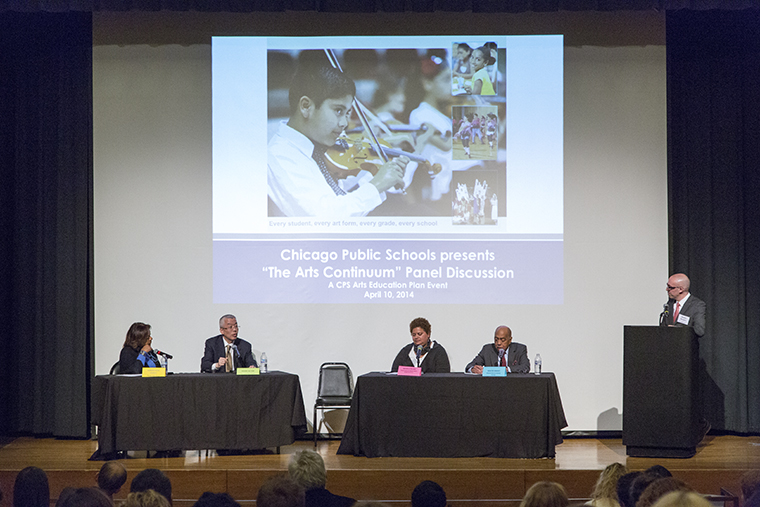Kim supports CPS arts education plan
April 14, 2014

President Kwang-Wu Kim participates in Chicago Public schools’ “Arts Continuum” panel April 10 along with Barbara Byrd-Bennett (far left), CEO of CPS.
In a show of backing for arts programs in public schools, President Kwang-Wu Kim spoke at the Chicago Public Schools Arts Education Plan’s April 10 “Arts Continuum” event, where community leaders gathered to discuss ideas for CPS’ first arts education plan.
The panel discussion was held at the Chicago Cultural Center’s Claudia Cassidy Theater, 78 E. Washington St., and focused on three major components of arts education in Chicago, including strategies to support and expand arts education for students, understand the value of arts education and anticipate a “game-changer” for the school district.
Other speakers included Walter Massey, president of the School of the Art Institute of Chicago; Barbara Byrd-Bennett, CEO of CPS; and Michelle Boone, commissioner of Chicago’s Department of Cultural Affairs and Special Events.
CPS’ Arts Education Plan was approved by the Chicago Board of Education in 2013, making arts education a core subject in grades K–12. The initiative was introduced in Mayor Rahm Emanuel’s 2012 Chicago Cultural Plan, which granted CPS $500,000 to fund its arts plan in addition to another $500,000 pulled from the city’s leftover NATO funds.
“A lot of our work is to provide the arts to every one of our students, in every grade, every corner of the city and in every neighborhood,” said Mario Rossero, director of CPS’ Department of Arts Education. “Our work is focused by our strategic arts plan, which has a series of policies, systems and different actions to improve different arts across the district.”
During the panel, Kim said although he is new to Chicago, he thinks the city is still segregated, and the arts will help children throughout their college careers and adult life.
“I’m really interested in promoting the idea that all kids in school should have access to studying the arts,” Kim said. “For me that was my excitement [about] being asked to get involved, because anything I can do to make that happen is important to me.”
Rossero said he invited Kim because of the sponsor support he and Columbia could provide in the future. Kim said he is interested in helping CPS become more arts-focused so students can continue their education in college, adding that Columbia should be a larger part of the city’s arts community.
“Columbia, in my mind, is a logical, level partner with CPS in this arts plan,” Kim said. “When I first got here, I didn’t sense within the politics in the city that [art] was being highlighted. For me, the most important part of [the panel] is that there is beginning to be recognition that Columbia College Chicago should be a part of this conversation.”
Rossero said Columbia is a strong player within Chicago’s arts community and that its focus on visual and performing arts makes it a valuable city asset.
“Columbia has a pretty gigantic footprint in Chicago as one of the leading colleges,” Rossero said. “From [a visual and performing arts] perspective, it was a no-brainer to have Columbia at the table.”
Byrd-Bennett said arts are important in education because of their positive effects on creative learning in students, noting that she grew up playing the viola.
“I absolutely know how important the arts are for serving as a motivator and serving as a teaching tool,” Byrd-Bennett said. “It serves as a vehicle to teach and motivate young people.”







